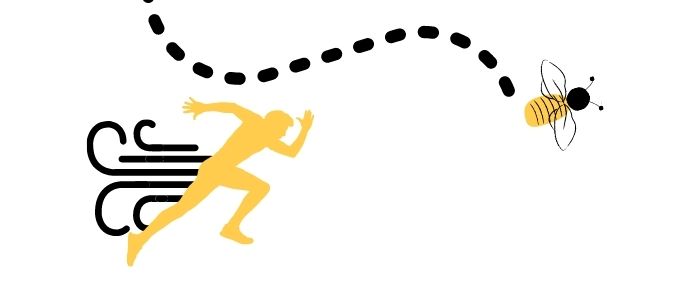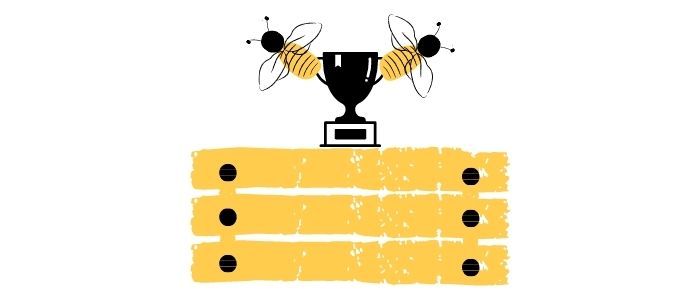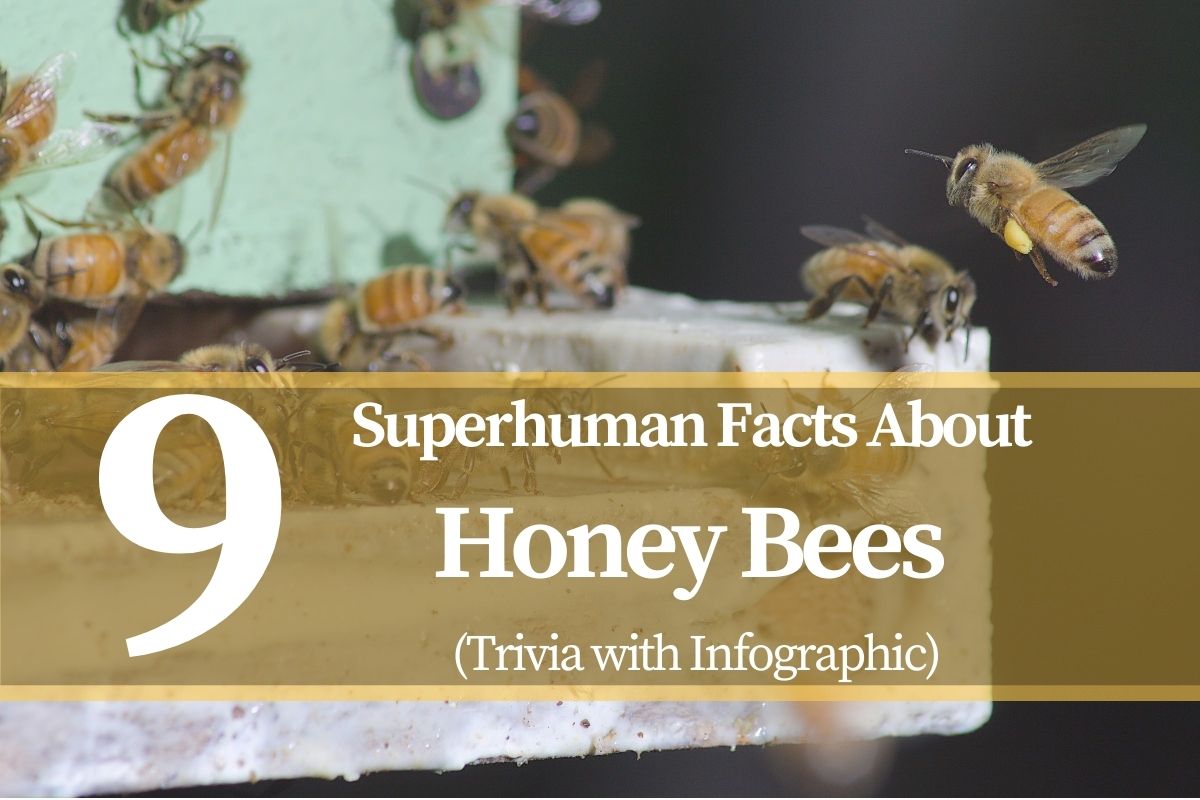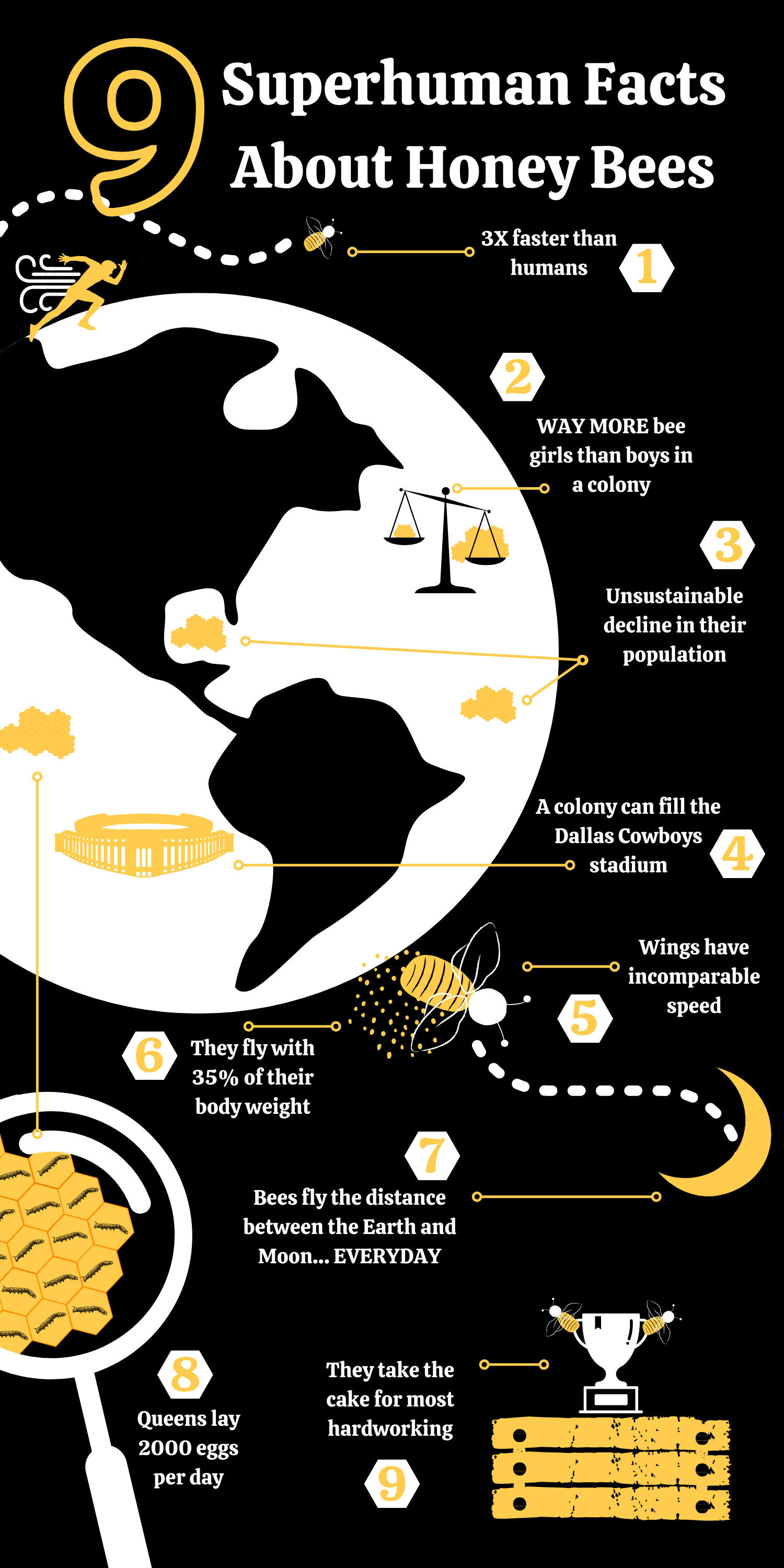I had a vague idea. We started exploring plans of a beekeeping business because, quite frankly, honey bees seemed interesting to me. Turns out they’re much more fascinating than I first thought! Honey bees offer a lot more than just honey and beeswax. I mean that literally and figuratively. So are you up for some bee trivia? Here’s a list of 9 facts about honey bees and how they stack up against us humans.
Table of Contents
1. Bees are 3 times faster than humans

Bees fly at around 15 mph (24 kph) to 18 mph (29 kph), with the fastest speed recorded at 20 mph (32 kph). Although Olympian Usain Bolt’s record-winning attempt averaged around 23mph (37 kph), the average man has a running speed of just 5.9 mph (9.5 kph).
That’s right, bees are approximately 3 times faster than the average male human, despite our size advantage. So be careful not to upset bees!
(Don’t worry though, they’re milder than what traditional media has portrayed.)
2. There are WAY MORE bee girls than boys in a colony

All worker bees are female honey bees. That saying a large portion of the population is female is a huge understatement. But how dominating is the balance in favor of female bees exactly?
The number of male bees, also called drones, ranges across colonies and species. For example, the Asian honey bee has around 200 male bees (drones) in a colony. A colony can range from 20,000 to 80,000 female workers. If we assume 40,000 female workers, that’s a 200:1 ratio.
200 female bees per 1 male bee.
How does this stack to us humans? The total human population has a ratio of 1.01 males per female. That’s approximately 1:1, with slightly more males than females.
3. A bee colony can fill the Dallas Cowboys stadium
Bee trivia number 3 is a fun fact. Let’s take the 20,000 to 80,000 population we mentioned in the previous number. How large is that exactly?
In terms of the human population, that’s approximately the size of a large university in the US. The largest of colonies are also about the size of a jam-packed Dallas Cowboys stadium (AT&T Stadium).

4. Honey bees fly the distance between the Earth and Moon… EVERYDAY

This one’s mind-boggling. Let’s say a colony has around 60,000 bees, which is a reasonable estimate. Each bee travels as far as 5 miles (8 kilometers), but usually less than that.
Now, the distance between the Earth and Moon is estimated to be 238,855 miles (384,400 kilometers).
If we assume there are 60,000 workers, it takes an average of 3.9 miles (6.28 kilometers) per worker for the colony to cover the same distance from the Earth to the Moon. Amazing!
Source: The British Beekeepers Association
5. They take the cake for most hardworking

A single worker bee weighs around 0.00025 pounds or about 0.004 ounces (0.1134 grams). It is capable of producing 0.02822 ounces (0.8 grams) of honey in her lifetime.
This means a worker bee produces honey that’s 7 times its body weight.
Here’s more.
Honey bees live on average 15 to 38 days in the summer and 150 to 200 days in the winter. This means 2 things: (1) They produce 7 times their body weight in about a month and (2) they live shorter lives during the busy season.
That takes the saying busy as a bee to a whole new level!
6. Honey bees fly with 35% of their body weight

According to the University of Florida, a colony of 20,000 honey bees collects around 125.66 pounds (57 kg) of pollen every year. They estimate a single bee is able to carry pollen as heavy as 35% of its body weight.
In human terms, that’s approximately the allowed checked baggage of airlines such as Delta and US Airways for a 140-pound (63 kg) passenger.
7. There has been an unsustainable decline in population
It’s not all rainbows and bees, unfortunately. This bee trivia is a sad one. For the last decade, the honey bee’s population decline has increased more and more. Losses of up to 90% have been seen in some regions, owing to what’s been called the colony collapse disorder.
With 3 million deaths as of this writing, COVID has claimed 0.04% of the total human population. One of the world’s worst disasters by death toll, World War II casualties have been estimated to total 70 to 85 million. That’s about 3% of the 2.3 billion world population during the war.
No matter how it’s framed, losing 90% of your population is nothing short of catastrophic.
8. Bee wings have incomparable speed
Honey bees don’t have the fastest wings in the world. The award probably belongs to this insect. But they still have tremendous speed. 230 times per second. That’s how fast a honey bee beats its wings.
Kind of strange to compare this to humans, but we’ll contrast this to blinking anyway. (Because why not…)
Humans blink around 200 times… every 10 minutes. Let’s be vivid here and say that again. The number of times you blink in 10 minutes is the number of times a honey bee beats its wings every second.
9. Queens lay 2000 eggs per day

There have been numerous claims to the exact number of eggs a honey bee queen lays in a day. Honey bee queens lay 1000 to 3000 eggs per day.
That’s an impressive number no matter what. I probably don’t need to tell you how that compares to us, humans.
Queens have mating flights where they mate with male honey bees midair. They mate with multiple drones, ranging from 1 to 40, during their mating flights.
A bit off-topic but equally interesting, drones have one sole purpose. And that is to mate with queen bees. They have larger eyes (believed to help spot queen bees during flight), do not help in caring for the hive, and die after mating.
Bonus section
In my research of honey bees, I’ve also collated a few more interesting tidbits which I’ve found to be very interesting. Hope you enjoy it!
If you’re only interested in the superhuman facts about honey bees, you may proceed to the infographic below this list.
Bee trivia on anatomy
- Honey bees have 2 stomachs. One stomach is used for digesting, like how humans use their stomachs. A special stomach is used for storing nectar, which they “vomit” to another bee back at the hive.
- They have 5 eyes. They have 2 compound eyes on the sides and 3 eyes at the top. A compound eye consists of countless small units, typical of insects. The 3 eyes on top are believed to be a defense mechanism from predators, as well as for seeing in the dark hive.
- The stingers have barbs which cause them to die. You may already know how honey bees die when they sting. The barbs on the stinger stick to mammals. This means honey bees lose a large part of their digestive tract when they try to fly away after stinging. But it also means they can sting other insects without dying.
- Honey bees have 170 odorant receptors. All this means is they have an advanced sense of smell. They use smell signals when choosing flowers or when attacking large predators.
Bee trivia on social order
- Only queen bees eat royal jelly. When a queen dies, the workers select a larva and feed it royal jelly. There have been conflicting studies though, on whether or not royal jelly should be credited for the making of queen bees. Let’s all stay tuned for further scientific updates.
- They use the mathematically most efficient structure. Honeycombs are hexagonally shaped (6 sides). When scrutinized with mathematical data, it’s been found that the hexagon shape uses the least amount of material to hold the most weight.
- Bees are loyal to flowers. Honey flavor depends on the flowers used by honey bees. Interestingly, honey bees tend to visit the same flowers if they’re available.
- Impeachment is a thing. Occasionally, worker bees replace their queen for a variety of reasons. Some reasons include an ill or aging queen. It’s not technically an “impeachment,” and the official name is called supersedure in bees.
Bee trivia on human impact
- The food we can eat. Of the thousands of species, the honey bee is the only insect that produces edible nutriments.
- The term “honeymoon” comes from Norse practice. Fermented honey was believed to increase fertility. New brides would consume mead to increase their chances of conceiving a baby on their honeymoon.
- Environmental productivity. Even without honey, there’s one compelling reason to have honey bees nearby. They radically improve the productivity of your other plants. Without bees, a lot of the plants we depend on would not survive.
- Scientists are studying the positive effects of bee venom. No conclusions have been made, but studies on bee venom’s impact on HIV are promising. Another positive medical application could be for dementia.
Other fun(NY) facts about honey bees
- Work depends. The younger worker bees stay in the hive, while older bees are tasked to gather food. Some bees are dedicated queen assistants, while others have the duty of removing dead bodies from the hive.
- They dance. Bees use a form of dance to communicate. They do a figure of 8 dance and shake their bodies when walking in the direction of the food source. The shaking becomes stronger when the food source is better.
- Pooping not allowed in the winter. When it’s winter and they’re stuck inside the hive, bees won’t defecate. They’ll wait until it’s clear outside to do their cleansing flight.
- Cocaine delirium. This report shows how honey bees react to cocaine. Remember the previous number about dancing? When bees get a dose of cocaine, they exaggerate their dance even more, essentially lying about the food source!
And that’s it! I enjoyed collecting these little tidbits of bee trivia. What other honey been fun facts and trivia did I miss and deserve a mention? Share them with the community in the comment section down below!
Bee trivia infographic

Honey Farm Starter documents our journey from novices to (hopefully) experts. If you’re feeling a bit intimated by all big words and don’t know where to start, this place is for you. We are Dan & Deanne, and our hope is to create a resource that’s as encouraging as possible for the everyday backyard beekeeper.


